#haroset
Photo
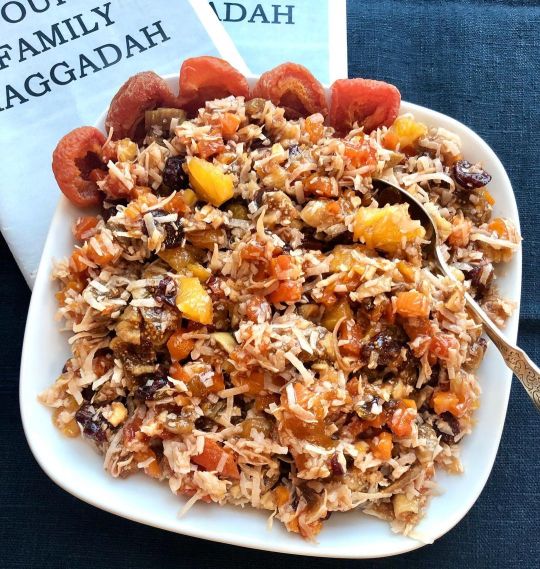
Last night I did a Passover cooking demo at Temple Beth El in Stamford, Connecticut. One of the dishes I prepared was this dried fruit and coconut Charoset. It’s a delicious and interesting change from traditional apple/walnut version and perfect if you have family with nut allergies, as we do. Btw, this a side dish — sort of like applesauce or cranberry sauce — so you can make this anytime and serve it with meat, chicken, fish and so on. It’s not just for Passover! Here’s the recipe: Dried Fruit and Coconut Charoset 1 cup chopped dried figs 1/2 cup chopped dried apricots 1/2 cup dried cherries or cranberries 1 navel orange 1 cup flaked or shredded coconut 2 teaspoons chopped fresh ginger 1/2 teaspoon ground cinnamon 1/2 cup apricot jam 1/3 cup sweet white or red Passover wine Combine the figs, apricots and cherries in a bowl. Slice the orange and cut the outer edges to remove the peel and white pith. Cut the flesh into small pieces and add to the bowl. Add the coconut, ginger, cinnamon, apricot jam and wine and mix ingredients. Let rest for at least one hour (preferably several hours) before serving. May be made a 2-3 days ahead. Makes about 3 cups #charoset #charoseth #haroset #passover #pesach #passoverfood #passover2023 #pesach2023 #seder #sederplate https://www.instagram.com/p/CqD8LjTP1Xq/?igshid=NGJjMDIxMWI=
3 notes
·
View notes
Photo

Haroset
This classic holiday relish is made with crunchy chopped apples and walnuts, just the right amount of sugar, cinnamon, and Kosher red wine. Before serving, chill the food to allow the sweet and spiciness to develop.
0 notes
Text

Sephardi Haroset
A Sephardic version of the Passover haroset made with dates, raisins, apricots, oranges, and spices.
1 note
·
View note
Text
Cannot believe I've never tried to top matzah brei with haroset I'm begging everyone this Passover to make sweet matzah brei and just put leftover haroset all over it. you can also add honey or a little parmesan cheese or both. Do it now it's tasty and delicious
2 notes
·
View notes
Text
Me 51 weeks of the year: "I am a proud Askenazi Jew!"
Me on and around Passover: "I'm Sephardic this week, thanks"
#Kniyot my beloved#A tradition I inherited from my parents#There is literally no comparison between the two traditions' haroset too
1 note
·
View note
Photo

Recipe for Date Haroset
To make a delicious treat for your holiday gathering, dates and raisins are simmered in a little wine, rolled with cinnamon and nuts, and dusted with confectioners' sugar.
0 notes
Photo

Haroset Recipe
This classic holiday relish is made with crunchy chopped apples and walnuts, just the right amount of sugar, cinnamon, and Kosher red wine. Before serving, chill the food to allow the sweet and spiciness to develop. 1 teaspoon white sugar, 1 cup finely chopped walnuts, 2 large apple - peeled cored and finely chopped, 2 tablespoons kosher red wine, 1 teaspoon ground cinnamon
0 notes
Photo

Fruit Desserts - Haroset
Crunchy chopped apples and walnuts are tossed with just the right amount of sugar, cinnamon and Kosher red wine to make this traditional holiday relish. Refrigerate, allowing the sweet, spicy flavors to blossom before serving.
0 notes
Text
Please reblog for bigger sample size and Chag Sameach!!
#polls#Jewish polls#jumblr#Passover#pesach#Passover 2023#pesach 2023#jumblr polls#we have shredded apple no nuts or raisins#my dad always makes it#and no cinnamon cause of family allergies
475 notes
·
View notes
Text
Yesterday was my first Passover Seder so here’s my opinion of the food
(Btw this is meant to be a joke. I understand the significance behind each food.)
Karpas : Tasted like soap 3.5/10
Matzah: I used to fuck up some matzah when I was in Jewish preschool. As tasty as I remember 9/10
Haroset: Tasty. 8/10
Maror: EYHS IT SPICY (even our rabbi agreed that we got the wrong brand 😵💫) 3/10
More bitter greens: Literally lettuce. I felt like a little rabbit 2/10
Zeroah: Didn’t even eat it, just kinda stared at it 8/10
Beitzah: bôįłęď éğġ. Unsalted. Went crazy 9/10
Grape Juice: Since I am underage, I somehow drank the 4 cups. So sugary…… 4/10
MATZOH BALL SOUP: MATZOH BALLED.WONDERFUL DINNER 100/10
24 notes
·
View notes
Photo

Passover is in a few weeks! So - I will be demonstrating some special family holiday recipes on March 20th at Temple Beth El in Stamford, CT. Here’s what’s on the menu: a colorful and unusual dried fig and coconut Charoset (recipe is in the profile and on my website) plus a really easy recipe for roasted salmon. I’ll also make some luscious salmon hash and finally, an up to date version of grandma’s dried fruit compote (those recipes are also on my website). It’s gonna be fun! Hope you can come if you live nearby! #passover #passoverrecipes #pesach #pesachrecipes #passover2023 #pesach2023 #cookingdemo #fooddemo #charoset #charoseth #haroset #charosis #figcharoset #coconutcharoset #roastedsalmon #salmonhash #driedfruitcompote #driedfruit #compote #stewedfruit #steweddriedfruit https://www.instagram.com/p/Cpi7hymrtL3/?igshid=NGJjMDIxMWI=
#passover#passoverrecipes#pesach#pesachrecipes#passover2023#pesach2023#cookingdemo#fooddemo#charoset#charoseth#haroset#charosis#figcharoset#coconutcharoset#roastedsalmon#salmonhash#driedfruitcompote#driedfruit#compote#stewedfruit#steweddriedfruit
3 notes
·
View notes
Text
As those of us familiar with Sephardic cuisine know, there are often different names and spellings for similar dishes. When it comes to baked casseroles of vegetables, egg and usually cheese, it could be called akuajado or quajado, sfongato or asfongato, fritada or frittata. Most often, “almodrote”is used by Turkish Jews when the dish is made with zucchini. “Kalabaza”(or calabaza) refers to squash, and is often used to describe different varieties of the vegetable.
Whatever it’s called, some form of this baked dish is nearly always served during Passover in Sephardic homes, and is usually included in the seder meal. It’s especially convenient because it can be made a day or two ahead (more if you want to freeze it) and doesn’t need to take up precious oven space, as it’s often served at room temperature or just barely warmed through. Almodroteand friends are also good for breakfast when you get tired of eating matzah and leftover haroset, or for lunch, dinner or cut into small squares for an appetizer.
This basic recipe can be adapted in many ways. While it calls for feta and parmesan, cheddar or kashkaval (a semi-hard cheese most often made from sheep’s milk that’s popular throughout the Balkans and Mediterranean), the cheese can be left out altogether to make it pareve, or you can use vegan cheese. Regular or gluten-free matzah meal can be used, or bread crumbs when it’s not Passover. You can also make it with other vegetables, including eggplant(berendjena), spinach (espinaka) or leeks (prasa), or add more of the herbs.
Traditionally in the no-waste Sephardic kitchen, the squash would be peeled and the peels made into a different dish. This dish, called kashkarikas, involves cooking the peels in a lemon and olive oil sauce, or with tomatoes and garlic. However, for extra nutrition and flavor, I don’t peel my squash.
17 notes
·
View notes
Text

Jewish woman preparing Haroset (a mixture of nuts, fruit and wine) for Passover. Derbent, Dagestan, 1962.
120 notes
·
View notes
Text
it's probably sacrilege but I made a peanut butter and haroset sandwich and let me tell you it fucking slaps my mother in law makes the best haroset and every passover I vow to eat more of it cause there's always leftovers anyway it's great
6 notes
·
View notes
Text
Why Passover Is One of Judaism’s (of The Real Jews Not of The Zionist 🐷 🐖 🐗 🐖) Most Important Holidays
Passover, one of Judaism's most revered holidays, honors the ancient Israelites' freedom from slavery in Egypt.
— By Erin Blakemore | April 15, 2024
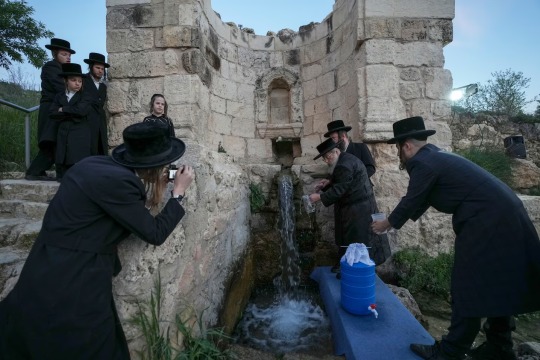
Rabbi Pinsk Karlin and other ultra-Orthodox Jews collect water from a spring to make matzoh, a traditional handmade unleavened bread for Passover, at a mountain spring in the outskirts of Jerusalem. Jews are forbidden to eat leavened foodstuffs during Passover. Photograph By Ariel Schalit, AP
As the days brighten and spring kicks into full swing, Jews all over the world prepare for Passover, a weeklong holiday that is one of Judaism’s most widely celebrated and most important observances. Also known by its Hebrew name Pesach, Passover combines millennia of religious traditions—and it’s about much more than matzoh and gefilte fish.
The Origins of Passover
The story of Passover can be found in the book of Exodus in the Hebrew Bible, which relates the enslavement of the Israelites and their subsequent escape from ancient Egypt.
Fearing that the Israelites will outnumber his people, the Egyptian Pharaoh enslaves them and orders every newly born Jewish son murdered. One son is Moses, whose birth has been foretold as the savior of the Israelites. He is saved and raised by the pharaoh’s daughter.

William Brassey Hole's "The Passage of the Red Sea" depicts the biblical story from Exodus in which God, acting through Moses, parts the Red Sea to allow the Israelites to cross to safety out of Egypt. Lebrecht History/Bridgeman Images
In adulthood, God speaks to Moses, urging him to tell Pharaoh to let his people go. But the pharaoh refuses. In return, God brings ten consecutive plagues down on Egypt (think: pestilence, swarms of locusts, and water turning to blood), but spares the Israelites.
During the final plague, an avenging angel goes door to door in Egypt, smiting every household’s firstborn son. God has other plans for the Israelites, instructing Moses to tell them to slaughter a lamb, then brush its blood on the sides and tops of their doorframes so that the avenging angel will “pass over.” Then they are to eat the sacrificial lamb with bitter herbs and unleavened—without yeast—bread. This is the last straw for Pharaoh, who frees the Israelites and banishes them from Egypt.
What’s on a Seder Plate
Modern Passover celebrations commemorate and even reenact many of the biblical events. The seder (“order”), the ritual meal that is the centerpiece of Passover celebrations, incorporates foods that represent elements of the story.
Bitter herbs (often lettuce and horseradish) stand for the bitterness of slavery. A roasted shank bone commemorates the sacrificial lamb. An egg has multiple interpretations: Some hold that it stands for new life, and others see it as standing for the Jewish people’s mourning over the struggles that awaited them in exile. Vegetables are dipped into saltwater representing the tears of the enslaved Israelites. Haroset, a sweet paste made of apples, wine, and walnuts or dried fruits, represents the mortar the enslaved Israelites used to build Egypt’s store cities.
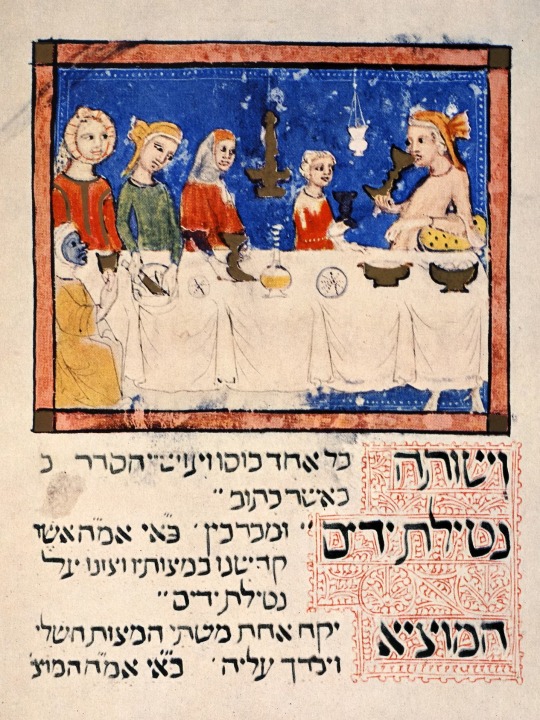
The centerpiece of modern Passover celebrations is the seder, a ritual meal commemorating the Israelites' escape from enslavement in Egypt. The dinner involves readings from a manuscript called the Haggadah. The Sarajevo Haggadah, pictured here, is one of the oldest, dating back to the 14th century. Photograph By Zev Radovan, Bridgeman Images
During a traditional seder, participants eat unleavened bread, or matzoh, three times, and drink wine four times. They read from a Haggadah, a guide to the rite, hear the story of Passover, and answer four questions about the purpose of their meal. Children get involved, too, and search for an afikomen, a piece of broken matzoh, that has been hidden in the home. Every seder is different, and is governed by community and family traditions.
How is Passover Celebrated
Passover observances vary in and outside of Israel. The holiday lasts one week in Israel and eight days in the rest of the world, in commemoration of the week in which the Israelites were pursued by the Egyptians as they went into exile.
During those days, many Jews refrain from eating leavened bread; some also abstain from work during the last two days of Passover and attend special services before and during Passover week. Orthodox and Conservative Jews outside of Israel participate in two seders; Reform Jews and those inside Israel only celebrate one.
But no matter where or how you observe Passover, its celebrations underscore powerful themes of strength, hope, and triumph over adversity and anti-Semitism.
A Brief History of Matzoh: 'It's Not Supposed To Taste Good'
Restrictions around matzoh are meaningful and refreshing to many: here’s why.
— By April Fulton | Published: May 17, 2023
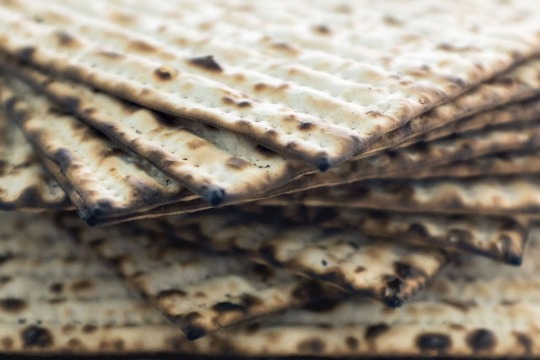
Matzoh is central to Passover, when Jews are prohibited from eating leavened food. Matzoh must be baked within around 18 minutes to prevent rising. Photograph By Becky Harlan, National Geographic Image Collection
Matzoh, known by Jews worldwide as “the bread of affliction,” is a cracker-like food made of flour and water eaten to commemorate the Hebrew slaves’ exodus from Egypt. The bland crisp takes the place of bread for the eight days of Passover.
While the aforementioned affliction may have changed over the years from one of desert-trekking deprivation to palatal hardship, most Hebrew scholars agree on one thing: It is not supposed to taste good.
Yet, for at least the first day of the holiday, many people actually crave it. Why?
For answers to this burning question about the nature of matzoh, we turn to Michael Wex, the author of Rhapsody in Schmaltz: Yiddish Food and Why We Can’t Stop Eating It.
“Now we eat it because we don’t have to eat it,” he says. In other words, because God’s chosen people have other choices the rest of the year, they look forward to eating matzoh to commemorate when Jews had no other choice but matzoh. And when it pops up in the grocery stores, many non-Jews pick up a few boxes, too.
According to the Hebrew bible, after a long protracted battle that featured God-directed plagues like frogs, boils, locusts, and the slaughter of first-born sons, the Egyptians freed the Hebrew slaves. The Jews left hastily, without time to let their bread rise. God basically tells them to take their dough and go, and that they’ll be cut off from Him if they eat anything leavened, i.e. yeasted or risen, for seven days. Hence—the first matzoh—the “roadside fast food from the ancient near East,” as Wex calls it.
The Passover seder dinner is centered around the matzoh, and is a virtual reenactment of the story of Exodus. In our family, the long, ritualistic dinner is frequently summed up for uninitiated guests in this way: “They tried to kill us, we’re still here, let’s eat.”
And so we eat matzoh, both plain and in forms that attempt to make it more palatable by adding salt and egg to create dumpling-like matzoh balls for chicken soup; or by topping it with sugary jam. Kids particularly love chocolate-covered matzoh for dessert.
Yes, there are other foods served at Passover, much of which varies according to where you’re from or what your grandma always made. Ours almost always includes brisket, kugel (a kind of casserole), and some kind of token vegetable. But matzoh is front and center.
There are strict specifications for making matzoh, of course. (Judaism is all about rules.) First of all, you only have 18 minutes from adding water to the flour to bake it. That’s the amount of time scholars say you have before the dough starts to rise, which would make the whole business un-kosher for Passover.
The result is a thin, flat plate-sized wafer “without even a kiss of salt,” Wex says. The first matzoh were probably round. The advent of machine-made matzoh led to the rise of the easier to pack and stack square marvel many of us know today. But the flavor? Pretty much the same, to my taste.
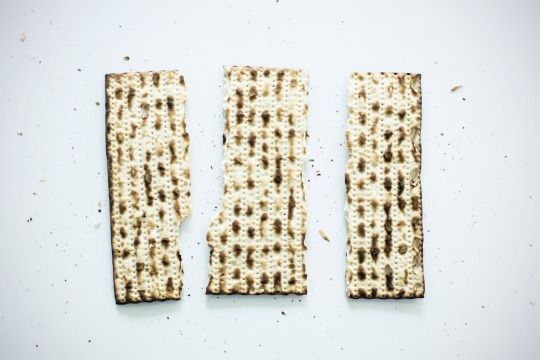
Traditional matzoh is broken ceremoniously at the beginning of the Jewish Passover seder.
There are also prescriptions for the matzoh to be harvested at a certain time of day and when it is dry enough, as prescribed by a rabbi, to prevent fermentation (i.e. leavening.) Dan Barber, back-to-the-land advocate and chef, made the case that the result of this close supervision may mean the wheat harvested is of higher quality, and therefore Jewish law may actually make food taste better.
But Wex and other scholars say this is beside the point. From Rhapsody in Schmaltz:
“There are those who say that God gave us cardboard so that we could describe the taste of matzoh, but taste is what matzoh is not about...Matzoh doesn’t need to be good, it only needs to be there—inside of 18 minutes. Or 22, according to some authorities; however long it took to walk to Tiberias from Migdal Nunia, the probable home of Mary Magdalene—a single Roman mile.”
Wex argues that the creation of Jewish dietary laws, particularly as they relate to matzoh, create for Jews a sense of otherness. While rules like no pork and no cheeseburgers may seem oppressive these days, in ancient times, it gave the Jewish people a new way of thinking. Once they were no longer slaves, they were “free to act in ways that have nothing to do with Egypt,” including, throwing out all their learned notions of what to eat.
There are entire Jewish communities, of course, who follow the ancient prescriptions to the letter for Passover and beyond. But do modern Jews still need to follow these ancient laws? Wex says you can have a strong Jewish conscience and not follow the dietary laws, but you should understand them “if you want your religion to stick around.”
The Very Ancient Passover of One of the Smallest Religions in the World
For thousands of years, the tiny Samaritan community has observed Passover according to its biblical laws.
— By Kristin Romey | Published: April 19, 2019
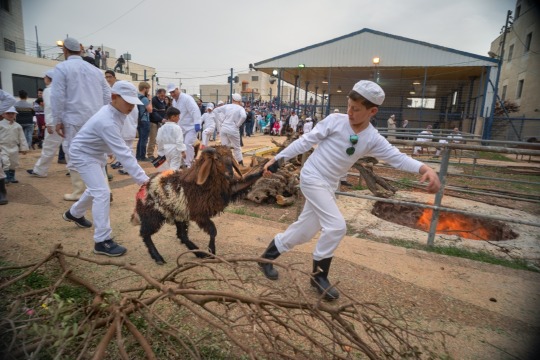
Samaritan boys wrangle a goat towards the sacrifice grounds on Passover eve in Kiryat Luza, West Bank. Photograph By Simon Norfolk
Samaritans are one of the world’s smallest religious groups, claiming descent from three of the 12 tribes of ancient Israel. They consider themselves the true observants of Israelite religion, and view Judaism as a religious practice corrupted during the Babylonian exile. This separation is clearly delineated in the geography of the Holy Land: While Mount Moriah in Jerusalem is where the Jewish Temple was decreed by God, the Samaritans followed the command of that same God and built their temple on the peak of Mount Gerizim, some 30 miles to the north.

Samaritan elders gather during the Passover eve sacrifice. There are a little more than 800 people in the Samaritan community, almost evenly divided between the Tel Aviv suburb of Holon and the West Bank village of Kiryat Luza. Photograph By Simon Norfolk
Today, Mount Gerizim, at an elevation of almost 3,000 feet, is one of the highest points in the Palestinian territories, and commands a sweeping view of the bustling city of Nablus and the West Bank villages that surround it. On its ridge is the village of Kiryat Luza, where, on the eve of each Passover, the roughly 800 members of the Samaritan community gather to pray and observe their liberation from slavery in Egypt.
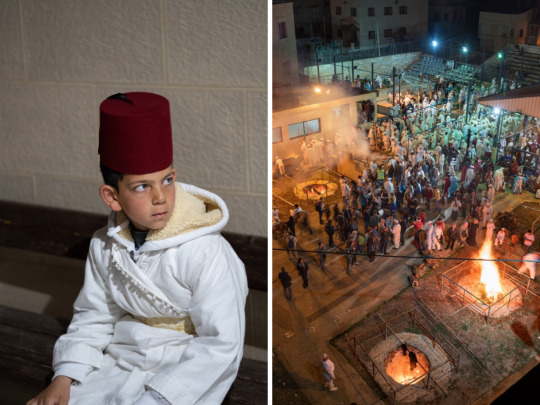
Left: A young Samaritan boy wears a distinctive red hat known as a tarbush. Right: worshipers and visitors mingle as the sacrificed goats roast for hours in large pit ovens. Photographs By Simon Norfolk
In remembrance of that event, the Samaritans follow the Torah mandate that a sheep or lamb be sacrificed on Passover eve and consumed before dawn of the next day. In Kiryat Luza, this is a communal event, in which prayers are recited and dozens of animals are dispatched simultaneously by men dressed in all white and then roasted in enormous earthen pits. In the hours after midnight, the meat is heaped on trays alongside bundles of bitter herbs and dished out in a celebratory community gathering under the stars.
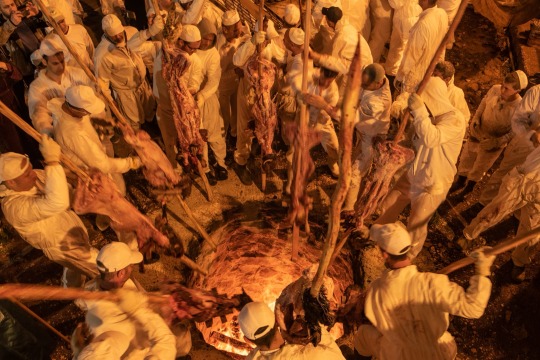
Following a group countdown, these Samaritan men will simultaneously plunge their skinned and dressed offerings into the blazing earthen oven. All of the meat must be eaten or burned before the sun rises on the first day of Passover. Photograph By Alessio Romenzi
Seven days later, the Samaritan community marks the end of Passover with a more solemn event. Once again under the stars just a few hours before dawn, the white-robed men of the community gather in front of their small synagogue, young sons beside them, rubbing the sleep from their eyes.
Led by their head priest cradling a silver Torah case, the men ascend Mount Gerizim in the darkness, climbing stone steps past the remains of their temple, destroyed by the Hasmoneans in the early second century B.C., and the rubble of a church built on their sacred peak by the Byzantine emperor Zeno some 600 years later. At points along the ascent, they stop to pray and then continue on as the dawn sky turns periwinkle and the paper-thin blossoms of scarlet poppies begin to unfurl.

On the seventh day of Passover, white-robed Samaritan men climb to the peak of Mount Gerizim, where their ancient temple once stood. Photograph By Simon Norfolk
The procession ends near a stone slab believed by Samaritans to be the site where Abraham intended to sacrifice his son Isaac. The sun breaks above the horizon and the high priest raises the shining Torah case above his head as he concludes the group prayer. It’s a spring day on Mount Gerizim, and once again this tiny community has gathered together to fulfill its sacred duties before God.
#Judaism ���️ | Holidays | Bible | Traditions | Diseases#History | Culture#Civilization#People#Water 💦#Ancient Egypt 🇪🇬#Religion#Baked Goods#Food 🍲🍱🥘
2 notes
·
View notes
Text
agh, his mom sent us home with so much delicious maror and haroset but we're out of matzo
1 note
·
View note